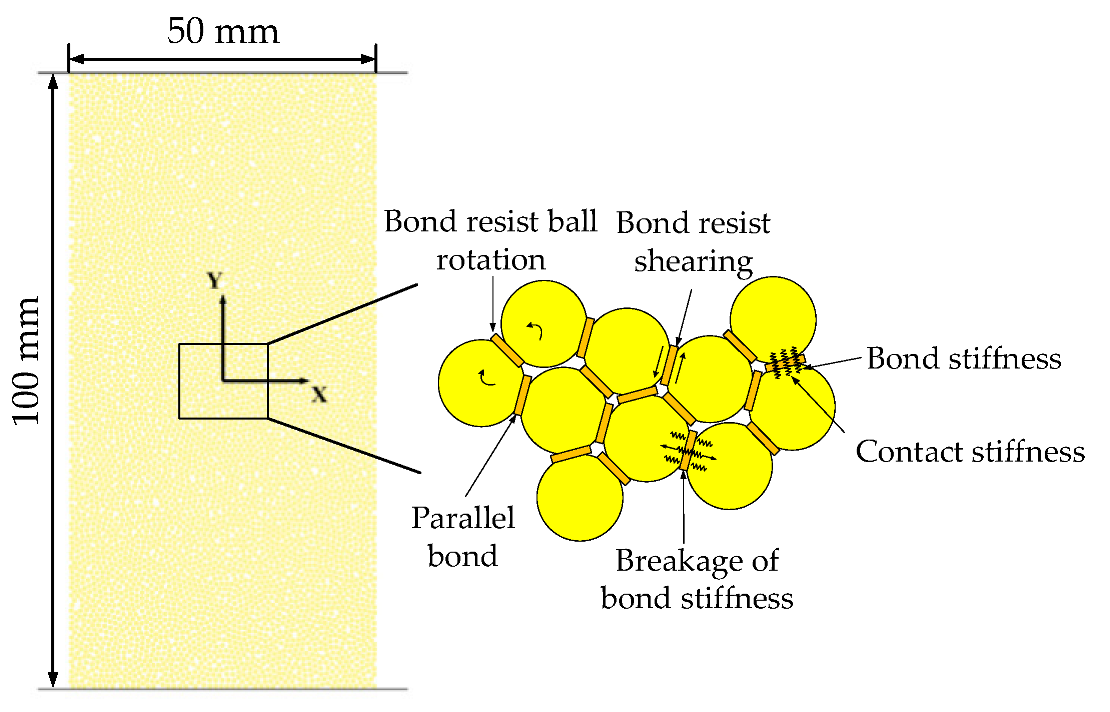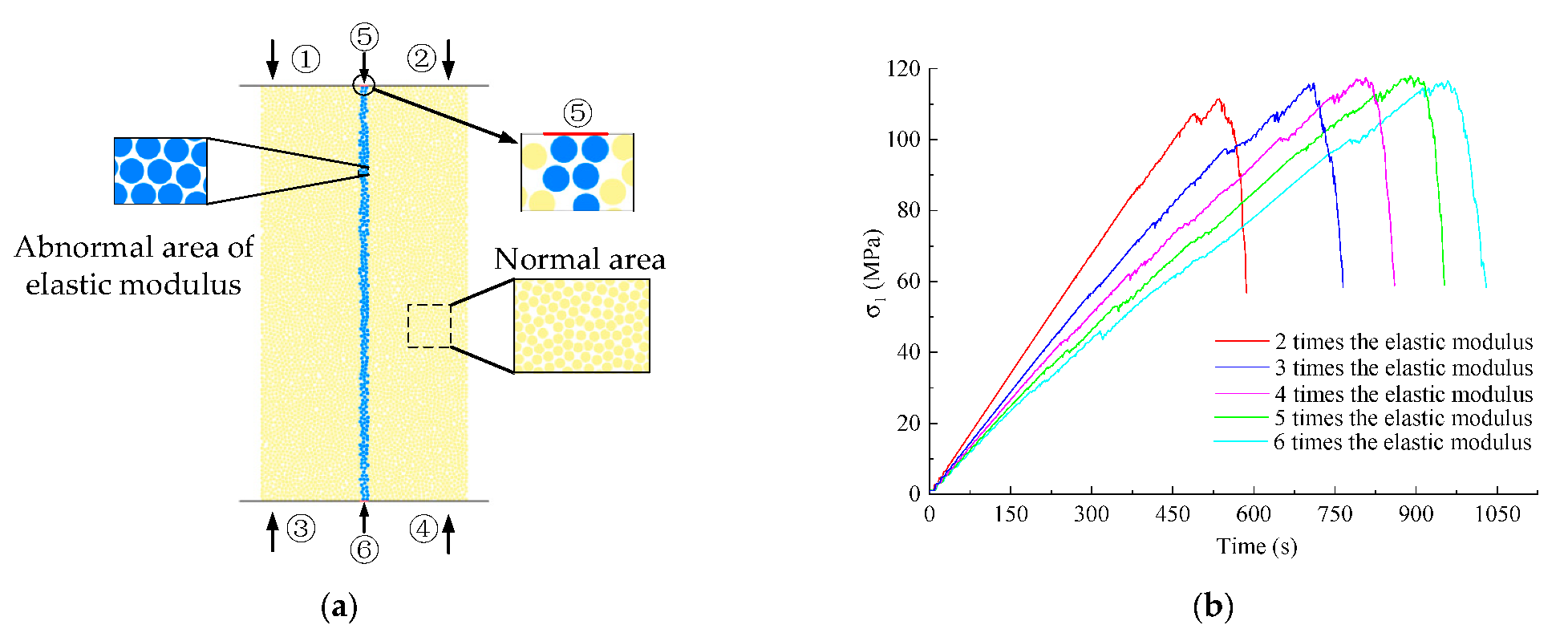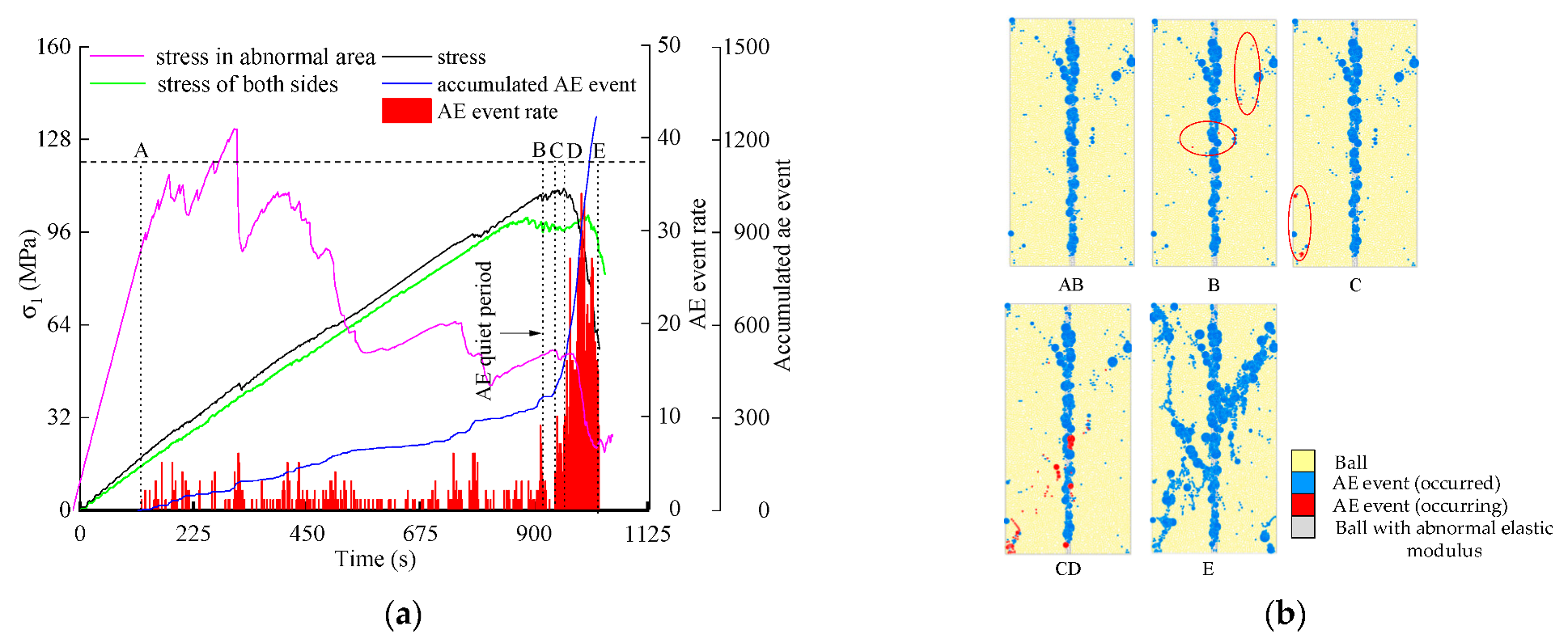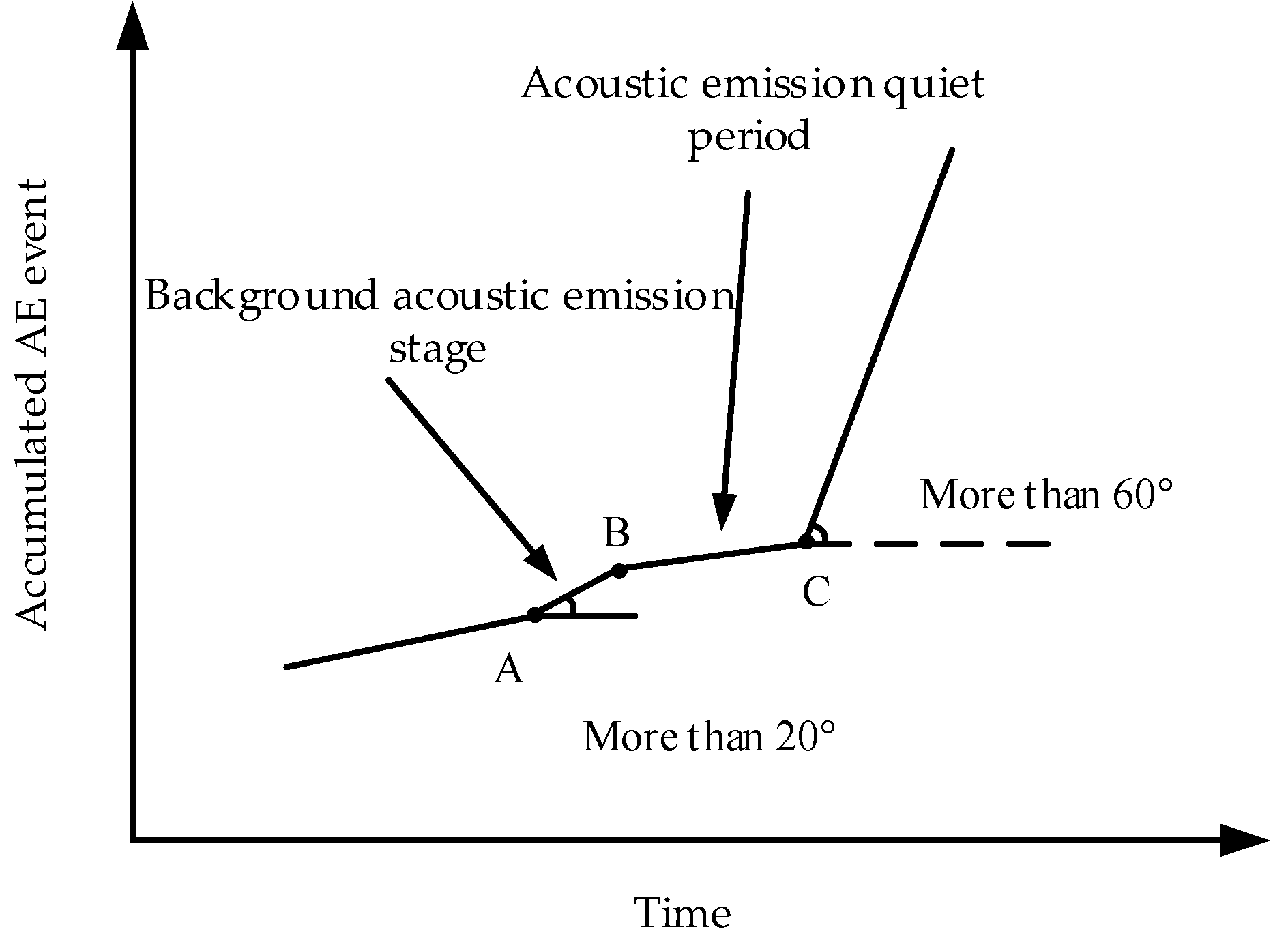Study on the Characteristics of Acoustic Emission Quiet Period in Rocks with Different Elastic Modulus
Abstract
:1. Introduction
2. Methods
2.1. Establishment of Particle Flow Model
2.2. Determination of Particle Flow Mesoscopic Parameters
2.3. Rock Model Construction in Elastic Modulus Abnormal Area
3. Results
- (a)
- Before point A. There are no cracks and AE events emergence in the stage of compaction;
- (b)
- Stages A−B. The model is at the stage between the crack initiation stage and AE quiet period. In Figure 5a, Figure 6a, Figure 7a, Figure 8a and Figure 9a the axial stress of the elastic modulus abnormal area increased to the maximum value in the AB stage, the peak stress of the abnormal area is 120% of that of the model, and the time to reach the maximum stress is, respectively, 90.2%, 57.9%, 45.2%, 37.6%, and 32.4% of the peak time, then decrease gradually. In Figure 5b, Figure 6b, Figure 7b, Figure 8b and Figure 9b the AE events were mainly concentrated in the abnormal area of the elastic modulus, and a small amount of AE events was generated in the normal area; the ratio of AE quantity between the normal area and the abnormal area is about 1:20;
- (c)
- Point B. The moment was defined before the quiet period of AE. In Figure 5a, Figure 6a, Figure 7a, Figure 8a and Figure 9a, the axial stress in the abnormal area of the elastic modulus decreases rapidly, and the axial stress in the normal area increases gradually; this shows that the abnormal area of the elastic modulus loses more carrying capacity and mainly relies on the normal areas for support. In Figure 5b, Figure 6b, Figure 7b, Figure 8b and Figure 9b, AE events corresponding to moment B are all appeared within the normal area;
- (d)
- Stages B to C. The quiet period of AE occurs in this stage;
- (e)
- Point C. In Figure 5a, Figure 6a, Figure 7a, Figure 8a and Figure 9a, the axial stress in the abnormal area of the elastic modulus increased, and the axial stress in the normal area decreased. In Figure 5b, Figure 6b, Figure 7b, Figure 8b and Figure 9b, a small number of AE events were generated in the normal area of the elastic modulus, and a crack zone was initially formed in the abnormal area of the elastic modulus. With the increase in the elastic modulus, the formation of the crack zone became more obvious. The elastic modulus abnormal area basically loses carrying capacity;
- (f)
- Stages C to D. The AE quiet period was ended. In Figure 5a, Figure 6a, Figure 7a, Figure 8a and Figure 9a, the axial stress in the abnormal area of the elastic modulus decreased gradually, and the axial stress in the normal area increased rapidly. In Figure 5b, Figure 6b, Figure 7b, Figure 8b and Figure 9b, the normal area resisted the main axial pressure, and the abnormal area and the normal area produced more cracks and AE events. The shear crack was formed when the microcracks propagation and the more obvious shear cracks tended to be formed in the specimens with a larger elastic modulus;
- (g)
- Stages D to E. The rock model produces a macro fracture while the axial stress reaches its peak. In Figure 5a, Figure 6a, Figure 7a, Figure 8a and Figure 9a, the axial stress in the abnormal area and normal area are slowing rapidly. The AE event rate and the cumulative number of AE events increased rapidly. In Figure 5b, Figure 6b, Figure 7b, Figure 8b and Figure 9b, numerous cracks and AE events were generated, a huge fracture appeared in the center of the model, and the model was destroyed.
4. Discussion
5. Conclusions
- (1)
- Before the occurrence of the main fracture of rock, the axial stress in the abnormal area increased maximum value, then decreased gradually; after the AE quiet period, it decreased rapidly. The axial stress on the normal area increased continuously;
- (2)
- Compared with homogeneous rocks, the AE quiet period of rocks with an abnormal elastic modulus is more significant. With elastic modulus increased, the time of rock failure and was increased, and the duration of the AE quiet period was prolonged one to five times. The Z value without abnormal area is the minimum of 1.1, and the elastic modulus of the abnormal area was set to three times the normal area, the Z value reaches the maximum of 6.08, and the AE quiet period is the most obvious. As the elastic modulus increases, the Z value is around 4. The distribution of different elastic modulus is an important factor concerning the characteristics of the AE quiet period;
- (3)
- At the initial stage of rock model loading, the axial stress in the abnormal area of elastic modulus increased rapidly, and the cracks and AE events were mainly concentrated on the abnormal area of the elastic modulus. The axial stress increased relatively slowly in the normal area, and a few cracks and AE events occurred. As the loading continued, the cracks gradually propagated from the abnormal area of the elastic modulus to the normal area. In the AE quiet period, the axial stress in the abnormal area of elastic modulus increased by 2%–5%. The abnormal area and normal area of elastic modulus were in the common loading state, which is the quiet period of AE.
Author Contributions
Funding
Institutional Review Board Statement
Informed Consent Statement
Data Availability Statement
Acknowledgments
Conflicts of Interest
References
- Shiotani, T.; Ohtsu, M.; Ikeda, K. Detection and evaluation of AE waves due to rock deformation. Constr. Build. Mater. 2001, 15, 235–246. [Google Scholar] [CrossRef]
- Lockner, D. The role of acoustic emission in the study of rock fracture. Int. J. Rock Mech. Min. Sci. Geomech. Abstr. 1993, 30, 883–899. [Google Scholar] [CrossRef]
- Wang, T.; Wang, L.; Xue, F.; Xue, M. Identification of crack development in granite under triaxial compression based on the acoustic emission signal. Int. J. Distrib. Sens. Netw. 2021, 17, 1550147720986116. [Google Scholar] [CrossRef]
- Meng, Q.; Chen, Y.; Zhang, M.; Han, L.; Pu, H.; Liu, J. On the Kaiser effect of rock under cyclic loading and unloading conditions: Insights from acoustic emission monitoring. Energies 2019, 12, 3255. [Google Scholar] [CrossRef] [Green Version]
- Yin, X.G.; Li, S.L.; Tang, H.Y.; Pei, J.L. Study on quiet period and its fractal characteristics of rock failure acoustic emission. Chin. J. Rock Mech. Eng. 2009, 28, 3383–3390. [Google Scholar]
- Hardy, H.R. Application of acoustic emission techniques to rock mechanics research. In Acoustic Emission, ASTM STP; ASTM International: West Conshohocken, PA, USA, 1972; Volume 505, pp. 41–83. [Google Scholar]
- Liu, D.; Jiang, S.; Tang, Y. Mechanical Properties of Metasandstone under Uniaxial Graded Cyclic Loading and Unloading. Appl. Sci. 2022, 12, 6310. [Google Scholar] [CrossRef]
- Liu, D.; Tang, Y.; Cao, M. Nondestructive testing on cumulative damage of watery fractured rock mass under multiple cycle blasting. Eng. Fract. Mech. 2021, 254, 107914. [Google Scholar] [CrossRef]
- Zhong, W.; Ouyang, J.; Yang, D. Effect of the in situ leaching solution of ion-absorbed rare earth on the mechanical behavior of basement rock. J. Rock Mech. Geotech. Eng. 2021. [Google Scholar] [CrossRef]
- Manthei, G.; Eisenblätter, J. Acoustic emission in study of rock stability. In Acoustic Emission Testing; Springer: New York, NY, USA, 2008; pp. 239–310. [Google Scholar]
- Rudajev, V.; Vilhelm, J.; Lokajíček, T. Laboratory studies of acoustic emission prior to uniaxial compressive rock failure. Int. J. Rock Mech. Min. Sci. 2000, 37, 699–704. [Google Scholar] [CrossRef]
- Zhao, X.D.; Tang, C.A.; Li, Y.H.; Yuan, R.; Zhang, J.Y. Study on AE activity characteristics under uniaxial compression loading. Chin. J. Rock Mech. Eng. 2006, 25, 3673–3678. [Google Scholar]
- Li, S.L.; Zhou, M.J.; Gao, Z.P.; Chen, D.X.; Zhang, J.L.; Hu, J.Y. Experimental study on acoustic emission characteristics before the peak strength of rocks under incrementally cyclic loading-unloading methods. Chin. J. Rock Mech. Eng. 2019, 38, 724–735. [Google Scholar]
- Wu, Y.; Li, X.Z.; Huang, Z.; Xue, S. Effect of temperature on physical, mechanical and acoustic emission properties of Beishan granite, Gansu Province, China. Nat. Hazards 2021, 107, 1577–1592. [Google Scholar] [CrossRef]
- Su, G.; Gan, W.; Zhai, S.; Zhao, G. Acoustic emission precursors of static and dynamic instability for coarse-grained hard rock. J. Cent. South Univ. 2020, 27, 2883–2898. [Google Scholar] [CrossRef]
- Manouchehrian, A.; Sharifzadeh, M.; Marji, M.F.; Gholamnejad, J. A bonded particle model for analysis of the flaw orientation effect on crack propagation mechanism in brittle materials under compression. Arch. Civ. Mech. Eng. 2014, 14, 40–52. [Google Scholar] [CrossRef]
- Grasselli, G.; Zhao, Q.; Lisjak, A.; Liu, Q. Numerical simulation of acoustic emission in rocks using FEM/DEM. In Rock Dynamics and Applications-State of the Art; CRC Press: Boca Raton, FL, USA, 2013; p. 149. [Google Scholar]
- Yousefpour, N.; Pouragha, M. Prediction of the post-failure behavior of rocks: Combining artificial intelligence and acoustic emission sensing. Int. J. Numer. Anal. Methods Geomech. 2022, 46, 1874–1894. [Google Scholar] [CrossRef]
- Liang, D.; Zhang, N.; Rong, H. An Experimental and Numerical Study on Acoustic Emission in the Process of Rock Damage at Different Stress Paths. Geofluids 2021, 2021, 8047755. [Google Scholar] [CrossRef]
- Manouchehrian, A.; Cai, M. Simulation of unstable rock failure under unloading conditions. Can. Geotech. J. 2015, 53, 22–34. [Google Scholar] [CrossRef]
- Peng, J.; Wong, L.N.Y. The, C.I. Influence of grain size on strength of polymineralic crystalline rock: New insights from DEM grain-based modeling. J. Rock Mech. Geotech. Eng. 2021, 13, 755–766. [Google Scholar] [CrossRef]
- Potyondy, D.O.; Cundall, P.A. A bonded-particle model for rock. Int. J. Rock Mech. Min. Sci. 2004, 41, 1329–1364. [Google Scholar] [CrossRef]
- Potyondy, D.O. The bonded-particle model as a tool for rock mechanics research and application: Current trends and future directions. Geosystem Eng. 2015, 18, 1–28. [Google Scholar] [CrossRef]
- Hazzard, J.F.; Young, R.P. Simulating acoustic emissions in bonded-particle models of rock. Int. J. Rock Mech. Min. Sci. 2000, 37, 867–872. [Google Scholar] [CrossRef]
- Hazzard, J.F.; Young, R.P. Moment tensors and micromechanical models. Tectonophysics 2002, 356, 181–197. [Google Scholar] [CrossRef]
- Li, X.F.; Li, H.B.; Liu, L.W.; Liu, Y.Q.; Ju, M.H.; Zhao, J. Investigating the crack initiation and propagation mechanism in brittle rocks using grain-based finite-discrete element method. Int. J. Rock Mech. Min. Sci. 2020, 127, 104219. [Google Scholar] [CrossRef]
- Liu, W.; Liu, J.; Zhu, C. Multi-scale effect of acoustic emission characteristics of 3D rock damage. Arab. J. Geosci. 2019, 12, 668. [Google Scholar] [CrossRef]
- Bu, F.; Xue, L.; Zhai, M.; Huang, X.; Dong, J.; Liang, N.; Xu, C. Evaluation of the characterization of acoustic emission of brittle rocks from the experiment to numerical simulation. Sci. Rep. 2022, 12, 498. [Google Scholar] [CrossRef] [PubMed]
- Meng, Y.; Jing, H.; Liu, X.; Yin, Q.; Wei, X. Experimental and numerical investigation on the effects of bedding plane properties on the mechanical and acoustic emission characteristics of sandy mudstone. Eng. Fract. Mech. 2021, 245, 107582. [Google Scholar] [CrossRef]
- Wang, Z.; Li, Y.; Cai, W.; Zhu, W.; Kong, W.; Dai, F.; Wang, K. Crack propagation process and acoustic emission characteristics of rock-like specimens with double parallel flaws under uniaxial compression. Theor. Appl. Fract. Mech. 2021, 114, 102983. [Google Scholar] [CrossRef]
- Jafari Mohammadabadi, B.; Shahriar, K.; Jalalifar, H.; Ahangari, K. Numerical Simulation for Predicting the Anisotropy of Faryab Cromite Rock Using PFC Software. J. Anal. Numer. Methods Min. Eng. 2021, 11, 23–35. [Google Scholar]
- Nguyen, N.H.; Bui, H.H.; Nguyen, G.D.; Kodikara, J. A cohesive damage-plasticity model for DEM and its application for numerical investigation of soft rock fracture properties. Int. J. Plast. 2017, 98, 175–196. [Google Scholar] [CrossRef]
- Goodman, R.E. Introduction to Rock Mechanics; Wiley: New York, NY, USA, 1989. [Google Scholar]
- Davarpanah, S.M.; Ván, P.; Vásárhelyi, B. Investigation of the relationship between dynamic and static deformation moduli of rocks. Geomech. Geophys. Geo-Energy Geo-Resour. 2020, 6, 29. [Google Scholar] [CrossRef] [Green Version]
- Yang, X.D.; Sun, L.H.; Song, J.L.; Yang, B.S.; Lan, C.R.; He, Q.F. Study on the effect of bond strength on the failure mode of coarse-grained sandstone in weakly cemented stratum. Minerals 2022, 12, 55. [Google Scholar] [CrossRef]
- Vallejos, J.A.; Salinas, J.M.; Delonca, A.; Mas Ivars, D. Calibration and verification of two bonded-particle models for simulation of intact rock behavior. Int. J. Geomech. 2017, 17, 06016030. [Google Scholar] [CrossRef]
- Jarolin, K.; Dosta, M. Linearization-based methods for the calibration of bonded-particle models. Comput. Part. Mech. 2021, 8, 511–523. [Google Scholar] [CrossRef]
- Li, G.; Bodahi, F.; He, T.; Luo, F.; Duan, S.; Li, M. Sensitivity Analysis of Macroscopic Mechanical Behavior to Microscopic Parameters Based on PFC Simulation. Geotech. Geol. Eng. 2022, 40, 3633–3641. [Google Scholar] [CrossRef]
- Zhou, Y.; Wu, S.; Xu, X.; Sun, W.; Zhang, X. Particle flow analysis of ae characteristics during rock failure process. Chin. J. Rock Mech. Eng. 2013, 32, 951–959. [Google Scholar]
- Habermann, R.E. Precursory seismic quiescence: Past, present, and future. Pure Appl. Geophys. 1988, 126, 279–318. [Google Scholar] [CrossRef]












| Rock Samples Number | Peak Stress (MPa) | Elastic Modulus (GPa) | Poisson’s Ratio |
|---|---|---|---|
| H−1 | 123.57 | 29.24 | 0.21 |
| H−2 | 114.97 | 29.09 | 0.18 |
| H−3 | 135.84 | 30.14 | 0.20 |
| H−4 | 150.22 | 36.17 | 0.23 |
| Microscopic Parameter | Value | Microscopic Parameter | Value |
|---|---|---|---|
| Particle size ratio | 0.25 | Radius factor of PBM | 1 |
| Porosity | 0.16 | Normal−shear stiffness ratio of PBM | 1.8 |
| Local damping coefficient | 0.7 | Effective modulus of PBM | 20 |
| Friction coefficient | 0.577 | Tensile strength of PBM | 5.4 × 106 |
| Particle density/Kg/m3 | 2500 | Cohesion of PBM | 6.4 × 106 |
Publisher’s Note: MDPI stays neutral with regard to jurisdictional claims in published maps and institutional affiliations. |
© 2022 by the authors. Licensee MDPI, Basel, Switzerland. This article is an open access article distributed under the terms and conditions of the Creative Commons Attribution (CC BY) license (https://creativecommons.org/licenses/by/4.0/).
Share and Cite
Zhao, K.; Wu, W.; Zeng, P.; Gong, C. Study on the Characteristics of Acoustic Emission Quiet Period in Rocks with Different Elastic Modulus. Minerals 2022, 12, 956. https://doi.org/10.3390/min12080956
Zhao K, Wu W, Zeng P, Gong C. Study on the Characteristics of Acoustic Emission Quiet Period in Rocks with Different Elastic Modulus. Minerals. 2022; 12(8):956. https://doi.org/10.3390/min12080956
Chicago/Turabian StyleZhao, Kui, Wenkai Wu, Peng Zeng, and Cong Gong. 2022. "Study on the Characteristics of Acoustic Emission Quiet Period in Rocks with Different Elastic Modulus" Minerals 12, no. 8: 956. https://doi.org/10.3390/min12080956
APA StyleZhao, K., Wu, W., Zeng, P., & Gong, C. (2022). Study on the Characteristics of Acoustic Emission Quiet Period in Rocks with Different Elastic Modulus. Minerals, 12(8), 956. https://doi.org/10.3390/min12080956





